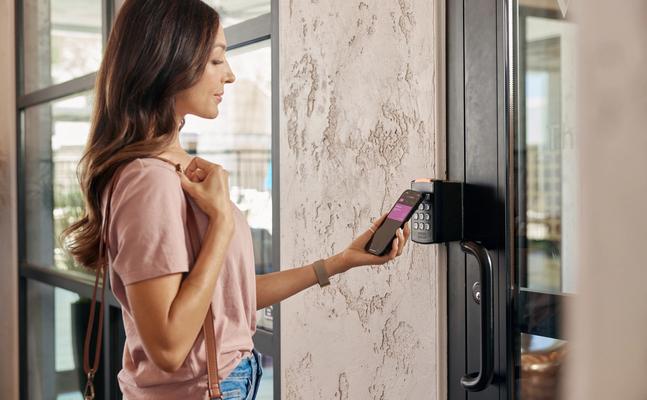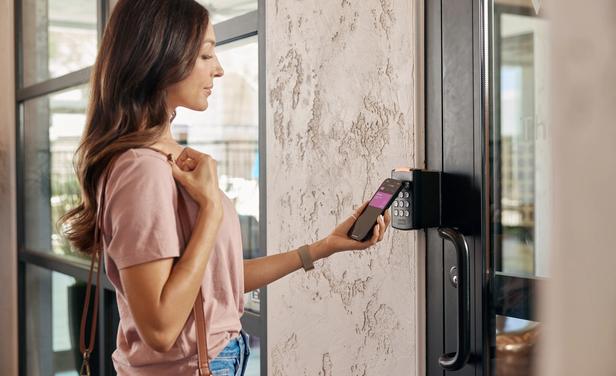The best access control system is the one that fits your community. That means it’s tailored to the needs of you, your staff, your residents, and your property.
You should also consider the technology on the market. How will a solution work with other proptech? And how will it scale?
Finally, consider how your staff and residents will interact with the system each day.

1. Think through all your access points
To build a full access control system, note all the places you have access points in your community. These might include:
Community gates
External building doors
Office doors
Pool gates
Fitness centers
Business centers
Elevators
Stairwells
Parking garage doors
Maintenance closets
Leasing offices
It can be helpful to plot each access point on a map of your community. This will allow you to see how access points are clustered around the property. And that, in turn, will help you decide what kind of controllers you need.
How to choose controllers
Controllers are the brains (and often the power source) for your access control system. Every time someone tries to enter an access point, the reader sends a signal to the controller to request permission. The controller validates the person’s credential and tells the lock to open.
There are two types of controllers:
A central controller is a single control panel that all access points connect to.
Edge controllers are smaller controllers that work together. They act like hubs, and each access point connects to one of several edge controllers.
If you have clusters of entry points around your community, edge controllers might work better and allow you to run fewer wires. But each one requires a secured area (and adds to your list of entry points).
If you have only one securable location for a controller, a central controller might be a better choice.
2. Consider who needs access where
After you have a list of access points and an idea of what kind of controllers you’ll use, think through who will need to use each access point. Make a list for each access point. Your lists could include:
Residents using their credentials
Residents who lost or forgot their credentials
New residents who need credentials
Prospective residents taking tours
Permanent guests, like a resident’s significant other, who visit often
Recurring guests, like dog walkers
Temporary guests, like friends or family visiting from out of town
Delivery drivers who need fast, temporary access
Your site team
Maintenance technicians, who need to move freely around the community and safely store tools and materials
Vendors, who may need full or limited access for a specific time period
Consider how each person will gain access and what entry method will work best for them. For example, biometric credentials like a fingerprint could work well for residents and staff. But requiring a fingerprint for every vendor or delivery driver might not make sense because you’d need to take their fingerprint in advance and store this private data somewhere secure. Instead, a temporary PIN code or intercom system might work better for them.
It’s a good idea to have two or three options for entry. This helps accommodate different types of users—and gives you a backup plan in case something goes wrong. If a resident injures their thumb and can’t provide a fingerprint, they (and your onsite staff) will be thankful there’s a keypad to type a PIN code into (using their uninjured index finger, of course).
3. Check out technical specs
There are a few other technical factors to consider when choosing hardware. The two biggest ones are power and protocol.
Power
There are two ways to power your access points: batteries and wires.
Batteries are usually simple to install, but you’ll need to ensure that your maintenance team can replace them promptly. Different kinds of readers and locks use different amounts of battery power, so battery life may vary. Most locks and readers use BLE (Bluetooth Low Energy) and have a very long battery life. Just know that the more use an access point gets, the faster it will use up battery power.
Wired access points are harder to install since you’ll need to run wires underground or through walls to bring power to the right place. But once all these lines are run, there’s little to no maintenance required.
Protocol
Protocol is the language your readers and locks use to talk to the controller. There are two kinds of protocols used in multifamily access control: OSDP and Wiegand.
Wiegand is the most common protocol, but it’s older and you can only run it up to 500 feet. Another downside is that it doesn't include encryption, and you’ll need to run extra wires if you want tamper protection.
OSDP (Open Supervised Device Control) is compatible with fewer kinds of hardware (though all of SmartRent’s devices support OSDP), but it has more cybersecurity features, can run for longer distances, and can handle more credential data. It also includes two-way communication, which means, if you pair it with the right lock, your controller will know when a door is left open.
4. Look for scalability and compatibility
When choosing an access control solution, keep the big picture in mind. Smart access control is often one of the first big investments in technology many community owners make. Some know they want to add additional proptech later, and others discover how convenient and cost effective access control is and begin to investigate other tech upgrades.
Whichever group you fall into, consider how compatible the solution you choose is with upgrades you make later—and whether you can scale it as your portfolio grows. When shopping for solutions, ask these questions:
How easily does the solution scale as you add more communities to your portfolio?
Can you integrate your access control system with multiple kinds of locks and readers if you decide to switch or upgrade hardware?
Does your access control system integrate with other proptech you might invest in later, like Community WiFi, Self-Guided Tours, or Work Management?
Can you start with a few pieces of equipment — like mobile readers on your most-used access points — then add to your system over time?
5. Consider the resident app and staff dashboard
As you narrow down your options, make sure you also consider the user experience of any apps or software that come with your access control system.
Help site teams get more done
The easier it is for your staff to manage credentials, rules, and permissions, the more efficiently they’ll wrap up these tasks. Some access systems even include automation features—like activating new resident credentials upon move-in and deactivating them at move-out, without your staff doing anything at all.
Something else to consider: How easy is it to customize your system for each of your communities? Can your site team limit how many guest passes residents give out—or even turn off the ability to issue guest passes altogether?
Resident satisfaction and retention
The quality of the resident app is crucial. It should be intuitive and effortlessly functional. If it takes more than a few seconds to unlock a door with a smartphone, or if people have trouble setting up temporary PIN codes for guest access, they’ll be frustrated with you and your community.
Avoid app fatigue
You’ll also want to avoid causing any app fatigue (https://smartrent.com/news/app-fatigue-and-how-to-fix-it/), which makes residents and staff reluctant to download yet another app onto their phones. It helps to have an access control system that integrates with the apps your community is already using, so they only need one app to live or work there.
6. Ask about installation
Installation happens just once over the lifetime of your access control system. But an installation that’s invasive, complicated, or drawn-out can wear on your staff and residents—not to mention your budget. Before you invest in access control, find out what installation looks like. Will a skilled team from your provider take care of professional installation? Or will your maintenance team handle it all? Does installation cost extra, or is it included?

The bottom line:
Choosing the right access control system for your community is crucial. Consider your community's needs, like the number and type of access points, and choose controllers and protocols that fit. Look for systems that are easy to scale and compatible with future upgrades. Make sure the user experience for both staff and residents is smooth and intuitive. And check the installation process to ensure it's hassle-free.
By taking these steps, you can implement a system that enhances security, efficiency, and resident satisfaction in your community.

